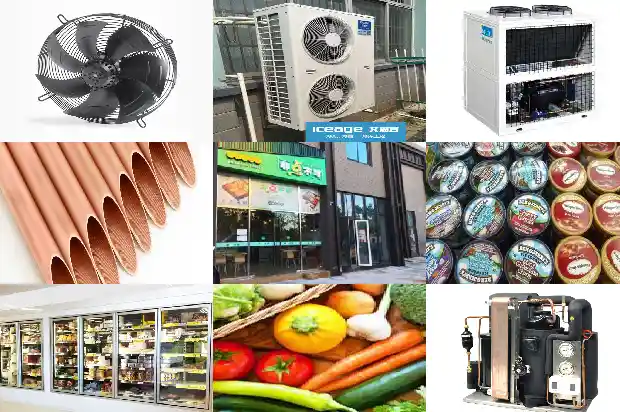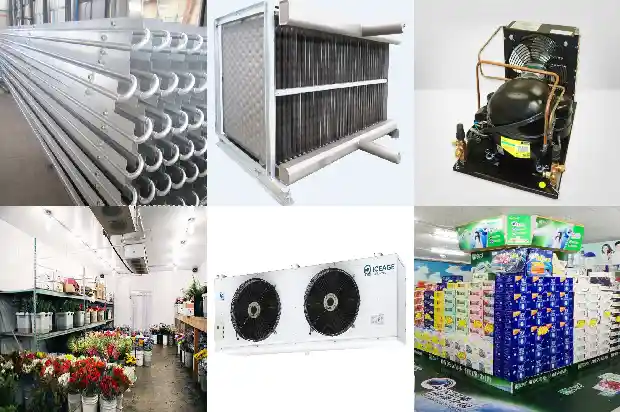Analysis of Classification, Differences, Advantages and Disadvantages of Cold Storage Refrigeration Compressors
2025-03-16
Introduction to Types of Cold Storage Refrigeration Compressors:
There are many types of cold storage compressors. As the main equipment in the refrigeration system, it converts electrical energy into mechanical work, compresses low - temperature and low - pressure gaseous refrigerants into high - temperature and high - pressure gases, ensuring the operation of the refrigeration cycle.
Compressors are mainly classified into the following types:
There are many types of cold storage compressors. As the main equipment in the refrigeration system, it converts electrical energy into mechanical work, compresses low - temperature and low - pressure gaseous refrigerants into high - temperature and high - pressure gases, ensuring the operation of the refrigeration cycle.
Compressors are mainly classified into the following types:
- Semi - hermetic refrigeration compressor: The refrigeration capacity is 60 - 600KW, and it can be used in various air - conditioning and cold - storage refrigeration equipment.
- Hermetic refrigeration compressor: The refrigeration capacity is less than 60KW, and it is mostly used in air - conditioners and small - scale cold - storage refrigeration equipment.
- Screw refrigeration compressor: The refrigeration capacity is 100 - 1200KW, and it can be used in medium - sized and large - sized air - conditioning and cold - storage refrigeration equipment.
Differences between Hermetic and Semi - hermetic Compressors:
Currently, the semi - hermetic reciprocating cold - storage compressor (and now screw compressors are becoming more and more common) is the main type in the market. The semi - hermetic reciprocating cold - storage compressor is generally driven by a four - pole motor, with a rated power usually between 60 - 600KW. The number of cylinders ranges from 2 to 8, and at most 12.
For hermetic compressors, the compressor and the motor it is equipped with share a main shaft and are installed inside a casing. Therefore, there is no need for a shaft seal device, reducing the possibility of leakage.
Advantages:
The compressor and the motor are installed in a casing welded or brazed shut, sharing a main shaft. This not only eliminates the shaft seal device but also greatly reduces and shrinks the size and weight of the entire compressor. Only the suction and exhaust pipes, the service pipe, and other necessary pipes (such as the spray pipe), the power input terminals, and the compressor bracket are welded on the outer surface of the casing.
Disadvantages:
It is not easy to open for repair. Since the entire compressor - motor unit is installed in a non - detachable sealed casing, it is difficult to open for internal repair. Therefore, this type of compressor requires high - reliability in use and a long lifespan. It also has high requirements for the installation of the entire refrigeration system. This hermetic structure is generally used in small - capacity refrigeration compressors produced in large quantities.
Semi - hermetic compressors mostly adopt the integral structure of the cylinder block - crankcase. The motor housing is often an extended part of the cylinder block - crankcase to reduce the connection surface and ensure the concentricity between the compressor and the motor.
The main shaft of the semi - hermetic compressor is in the form of a crankshaft or an eccentric shaft. The built - in motor can be cooled by air, water, or the suction of low - temperature working fluid vapor.
This lubrication method has a simple structure. However, when the power of the compressor increases and there is insufficient oil supply, it is changed to the pressure - lubrication method.
Advantages:
Currently, the semi - hermetic reciprocating cold - storage compressor (and now screw compressors are becoming more and more common) is the main type in the market. The semi - hermetic reciprocating cold - storage compressor is generally driven by a four - pole motor, with a rated power usually between 60 - 600KW. The number of cylinders ranges from 2 to 8, and at most 12.
For hermetic compressors, the compressor and the motor it is equipped with share a main shaft and are installed inside a casing. Therefore, there is no need for a shaft seal device, reducing the possibility of leakage.
Advantages:
The compressor and the motor are installed in a casing welded or brazed shut, sharing a main shaft. This not only eliminates the shaft seal device but also greatly reduces and shrinks the size and weight of the entire compressor. Only the suction and exhaust pipes, the service pipe, and other necessary pipes (such as the spray pipe), the power input terminals, and the compressor bracket are welded on the outer surface of the casing.
Disadvantages:
It is not easy to open for repair. Since the entire compressor - motor unit is installed in a non - detachable sealed casing, it is difficult to open for internal repair. Therefore, this type of compressor requires high - reliability in use and a long lifespan. It also has high requirements for the installation of the entire refrigeration system. This hermetic structure is generally used in small - capacity refrigeration compressors produced in large quantities.
Semi - hermetic compressors mostly adopt the integral structure of the cylinder block - crankcase. The motor housing is often an extended part of the cylinder block - crankcase to reduce the connection surface and ensure the concentricity between the compressor and the motor.

The main shaft of the semi - hermetic compressor is in the form of a crankshaft or an eccentric shaft. The built - in motor can be cooled by air, water, or the suction of low - temperature working fluid vapor.

This lubrication method has a simple structure. However, when the power of the compressor increases and there is insufficient oil supply, it is changed to the pressure - lubrication method.
Advantages:
- It can adapt to a wide range of pressure and refrigeration capacity requirements.

- It has a relatively high thermal efficiency and consumes less power per unit, especially when the air valve exists, this is more obvious when operating away from the designed working conditions.
- It has low requirements for materials, mostly using ordinary steel materials. It is relatively easy to process and has a relatively low cost.

- It is technically more mature, and rich experience has been accumulated in production and use.
- The device system is relatively simple.
The above advantages of the semi - hermetic reciprocating compressor make it the most widely used and the largest - batch - produced model in various refrigeration and air - conditioning devices, especially in the medium - and small - capacity ranges. At the same time, the semi - hermetic reciprocating compressor not only retains the advantages of the open - type compressor, which is easy to disassemble and repair, but also eliminates the shaft seal device, improves the sealing situation, makes the unit more compact in structure, and has a low noise. When the low - temperature working fluid sucked in is used to cool the motor, it is beneficial for the miniaturization and lightweight of the machine.
Currently, semi - hermetic reciprocating refrigeration compressors using R22, R404a, etc. for medium - and low - temperature applications are widely used in cold storage, refrigerated transportation, frozen processing, display cabinets, kitchen refrigerators, and other fields.
Related Articles
- A Brief Analysis of Quick - Freezing Cold Storage Design
- Analysis of the Causes of Frost Formation at the Suction Port of the Refrigeration Compressor
- Analysis of Common Faults of Chillers
- Analysis by Experts: Why Does the Four-way Reversing Valve Fail?
- Analysis of the Main Functions and Components of Refrigeration Air Conditioners
- Brief Analysis of Commonly Used Automatic Control Devices in the Refrigeration System
- Analysis of Common Auxiliary Components in the Refrigeration System One by One
- A Detailed Analysis of the Nine Reasons for the Low Pressure in the Refrigeration System!
- Analysis of the Working Process and Principle of Hot Fluoride Defrosting for Air Coolers
- Advantages and Disadvantages of Air-cooled Multi-connected Units and Analysis of Their Components
- Cause Analysis of High Discharge Temperature and Overload Protection of Modular Units
- Analysis of the Causes and Hazards of Corrosion in the Circulating Water System
- Analysis of Common Auxiliary Components in the Refrigeration System
- Analysis of the Composition, Control and Operation Process of Cold Storage System
- Analysis of Causes for Compressor Liquid Hammer, Overheating and Pre - heating
- Analysis of Seven Reasons for Ice Formation in Computer Room Air Conditioners
- Analysis and Troubleshooting of Common Faults in Air - source Heat Pumps
- Analysis of 6 Components in Air - cooled Multi - split Systems
